Dehydrated Beef Stroganoff
This post may contain affiliate links.
Now you can make your own backpacking beef stroganoff using a home dehydrator! Recreate the creamy, savory, and deeply satisfying flavor of one of the most iconic backpacking meals ever produced (for a fraction of the price!).
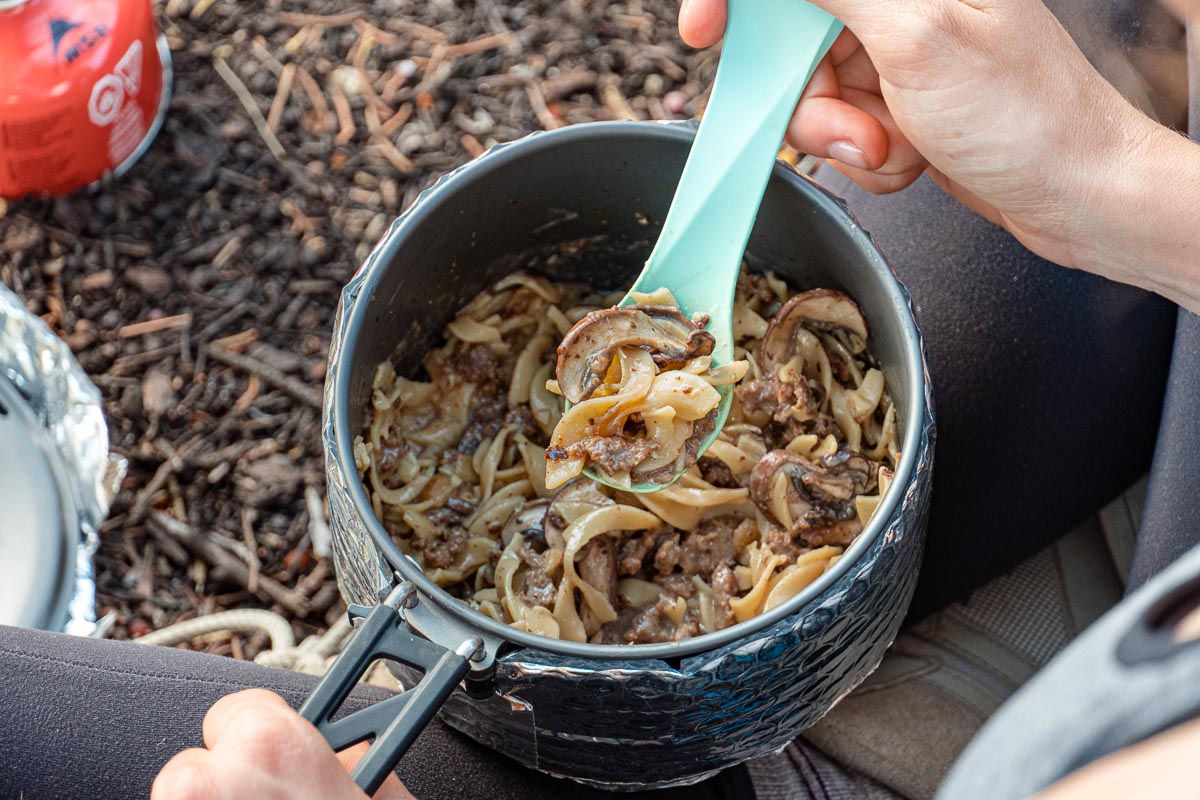
In the world of backpacking meals, Beef Stroganoff is legendary.
Popularized by Mountain House, and later adopted by many freeze-dried brands including Backpacker’s Pantry, stroganoff has been a crowd favorite of backpackers for decades. Personally, it is one of our “heavy rotation” freeze-dried meals and usually makes at least one appearance on any trip we take.
The blend of filling egg noodles, hearty ground beef, savory mushrooms, and luxurious, creamy sauce hits all the right notes. After a long day on the trail, this is exactly the type of warming and satisfying meal experience we are looking for. Just straight comfort food.
So in homage, we set out to create our own homemade dehydrator version. While we attempted to keep relatively true to the original, we thought there were a few areas that could be “enhanced”. Namely, more mushrooms and a creamier sauce.
This post shares our odyssey to recreate this backpacking classic and shows you how you can, too, using a home dehydrator. The result is basically a “Gourmet Makes” version of the Mountain House meal. It’s everything you expect from the original, just more of it and better.
Looking for a car camping version of Beef Stroganoff? We’ve got you covered. Check out our Cast Iron Beef Stroganoff recipe.
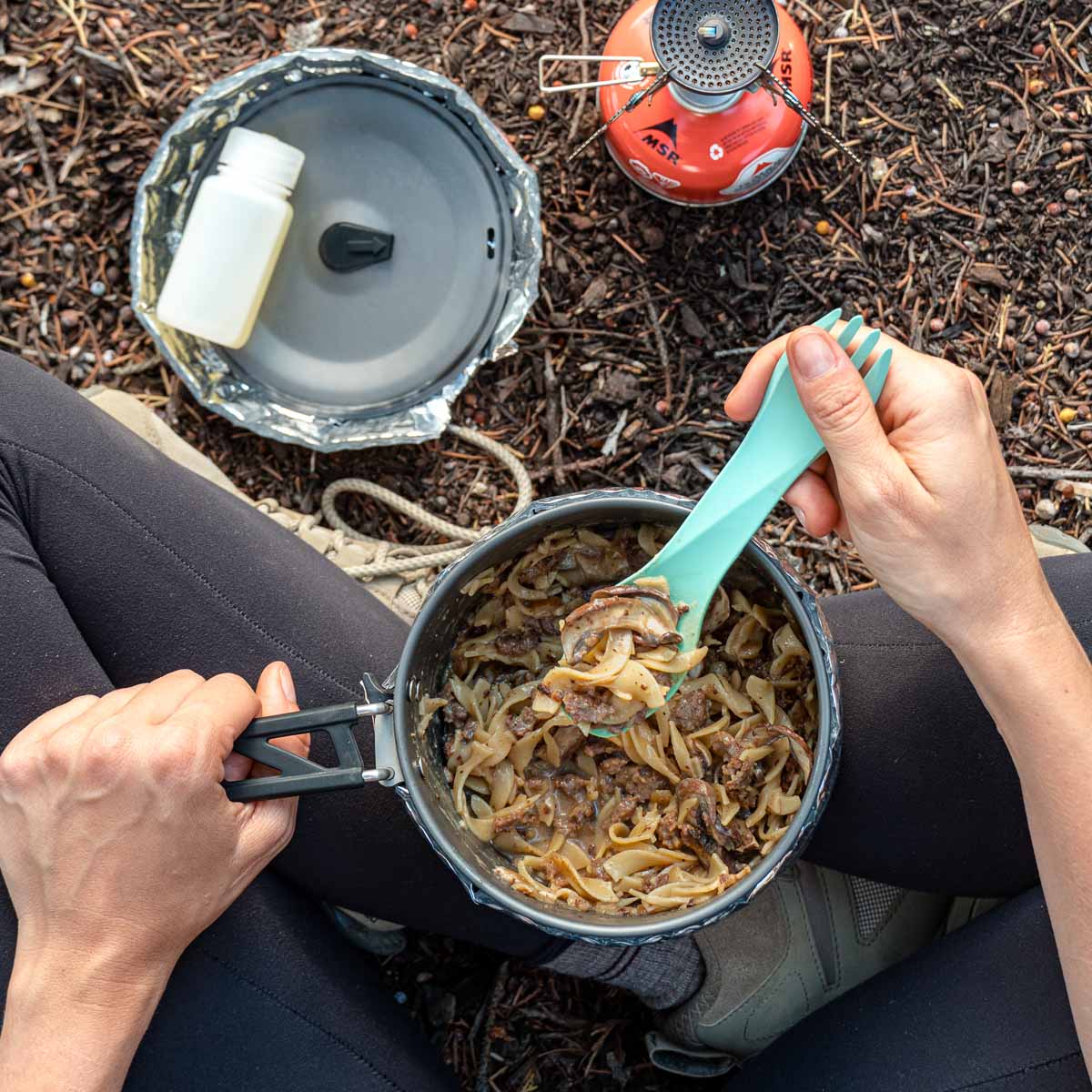
Why We Love Dehydrated Beef Stroganoff
- Beloved classic that you can now make at home
- Deeply satisfying backcountry comfort food
- Make it vegetarian by skipping the beef (doubling mushrooms)
- A fraction of the price as the store-bought version
If you’re looking to create your own version of this backpacking classic, consider making dehydrated beef stroganoff. We’ll show you how!
If you’re new to dehydrating, read our complete guide to dehydrating food for backpacking to learn all the ins and outs!
Equipment needed
Dehydrator: Any dehydrator that has an adjustable temperature setting will work. We own both the Nesco Snackmaster 75 (budget-friendly) and a Cosori (more features and dries faster) and would recommend either.
Reusable bags: In our bid to reduce our disposable ziplock bag consumption, we’ve started packing our dehydrated meals for the trail in reusable baggies. ReZip is a great option, balancing durability with weight. Most of their bags weigh between ½ – 1 oz.
Stove, pot, and cozy: To make this recipe on the trail, you’ll need a backpacking stove (this one is our favorite), a cookpot, and a pot cozy (optional—this will help you save fuel. See our DIY pot cozy tutorial to make your own).

Ingredient notes
These are notes about the ingredients in this recipe and why we added them—for exact measurements, head down to the recipe card.
Ground beef: Use the leanest ground beef you can find—excess fat will not dehydrate and will shorten the shelf life of your meal. If you want to skip the beef, you can use steamed lentils or TVP instead.
Breadcrumbs: Straight ground beef doesn’t rehydrate well. It can be hard and dense, leading to its trail nickname as “gravel”. The trick is to mix the beef together with breadcrumbs. Traditional or Panko both work great. The absorptive breadcrumbs help the ground beef rehydrate, giving it a much more appealing texture. (Omit if using lentils/TVP instead of ground beef).
Powdered Heavy Cream: Traditional stroganoff is made with sour cream, but after extensive testing, we concluded it’s just not possible to dehydrate sour cream. The taste, the texture, it’s all just wrong. And while powdered sour cream is available online, the reviews are pretty bad (so even the pros can’t get it right). Therefore, we suggest buying powdered heavy cream online instead. Not only does it work perfectly for this recipe, but it’s a much more versatile ingredient. It’s great for a lot of different sauces and baking applications.
Mushrooms: Dehydrate your own, use store-bought dried mushrooms, or pick up a container of freeze-dried mushrooms. In the recipe below, we give instructions for dehydrating them along with the meat and noodles. White button or cremini are the standard, but you could take this meal to the next level with some oyster or shiitake mushrooms.
Noodles: Beef stroganoff is traditionally made with egg noodles. We personally prefer the extra broad noodles but any type you like will work. Need something that’s gluten-free? Manischewitz makes a great gluten-free wide egg noodle, and Jovial has a gluten-free tagliatelle that would work great too.
Sauce Base: There are two ways to make the sauce base. Use a stroganoff sauce packet to make things easy. Or, build your own using heavy cream powder, cornstarch, and beef bouillon. We tested this recipe with Better Than Bouillon Beef Base and Knorr Beef Bouiliion powder and both worked well.
How to make dehydrated beef stroganoff
At home, start with clean, sanitized equipment, hands, and work area. This is super important for food safety when dehydrating, so wash up with soap and hot water! Preheat your dehydrator at 145F as you prep the stroganoff.
In a bowl, mix the ground beef with the breadcrumbs until thoroughly combined. At this point, wash your hands again.
Heat a non-stick frying pan over medium heat and add the ground beef, minced onions, and minced garlic. Use your spatula to break the meat apart as you stir it around the pan.
IF needed, you can add a minimal amount of oil to saute, but we find that the fat that renders out of the beef is usually sufficient.
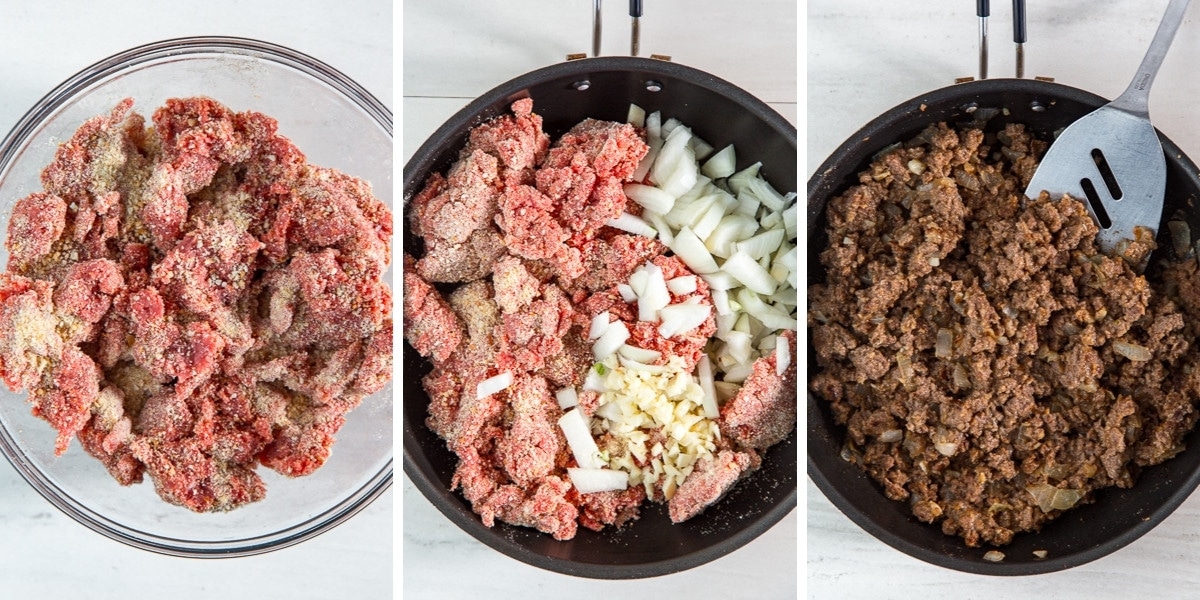
Cook 15-20 minutes until the ground beef has cooked all the way through and no pink spots remain and the onions are soft and translucent. If any large clumps of beef remain, break them apart.
Mix the cornstarch and bouillon with about a half cup of water to create a slurry, and pour into the pan, stirring to incorporate it into the sauce. Cook about one minute more, then remove from the heat.
While the beef is cooking, bring a pot of water to a boil and cook the noodles for a minute or two less than the package instructs you to. Slightly undercooking them will help prevent them from getting too overcooked during the rehydration process.

Line your dehydrator trays with fruit leather liners, parchment paper, or silicone sheets. Spread the beef, sliced mushrooms, and cooked noodles onto the trays, making sure not to over-pack the trays. You want to allow for good airflow between the food during the dehydration process. You’ll also want to make sure the noodles aren’t sticking together too much—we’ve found that the slightly curly shape of the egg noodles tends to make them double up.
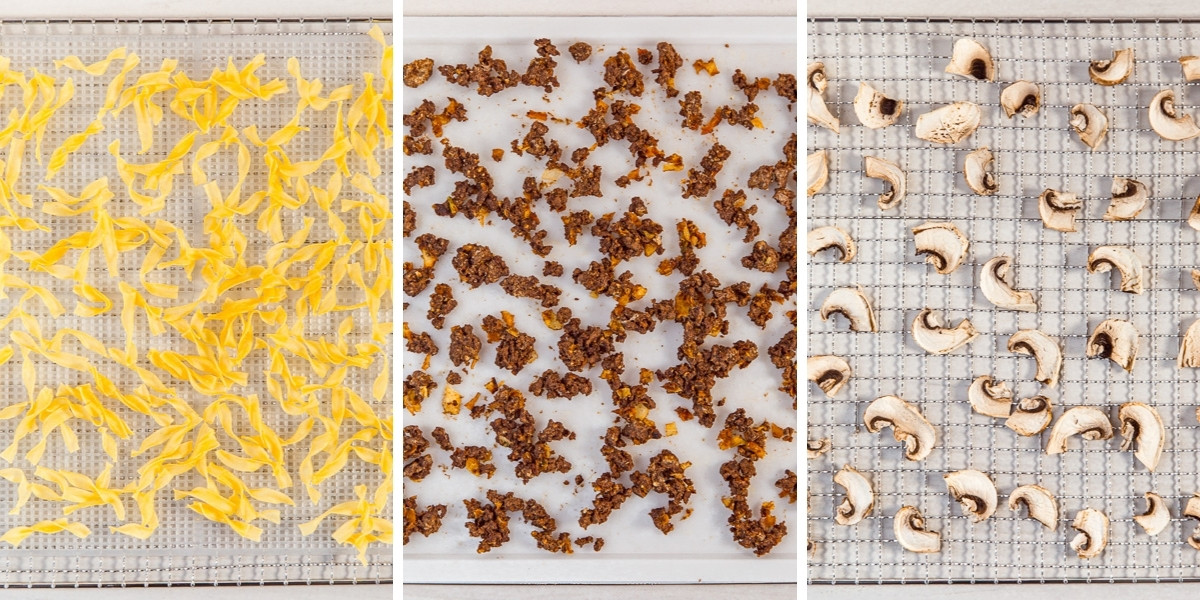
Dehydrate at 145F for 6-12 hours. A few times during the drying process, blot the beef with a paper towel to absorb any fat that has surfaced, and if using a vertical flow dehydrator, reshuffle the trays. The beef and noodles will be hard once completely dry, and the mushrooms will snap in half if you try to bend them.
Remove the stroganoff from the dehydrator and allow it to cool completely before storing it.
If you’ll eat this stroganoff within two weeks, it can be stored in an airtight container in a cool, dark place.
If you will need to store the meal for longer than two weeks, vacuum seal the stroganoff (or at least the meat) and store it in a cool, dark place for up to 1-2 months, or vacuum seal and freeze for extended storage (up to 6 months).
To pack for the trail: If needed, repackage the meal into single-portion zip-top bags. You can add the powdered heavy cream at this time (1 tablespoon per serving). We also recommend packing about 1 tablespoon of oil per serving in a sealed container. Alternatively, you can pack single-serve olive oil packets.

On the trail, place the meal in your cookpot along with about 200mL water per serving. Cover the pot and bring to a boil, and boil for a minute. Stir, then remove from the heat and place your pot in a pot cozy for 10 minutes or until the meal has rehydrated.
If you’re not using a pot cozy, bring the meal to a boil and then reduce to a simmer until rehydrated.
Read this next: Here are dozens of lightweight backpacking recipes to try on your next backpacking trip!
Storage tips
Properly dehydrated meat lasts 1 to 2 months (source: USDA) or 6 months if vacuum sealed and frozen (source: The Dehydrator Cookbook).
Of course, some report that their dehydrated food lasts much longer than the timeframes listed above, but these are the general guidelines we follow based on the listed sources. And, some foods may not last as long due to dehydrating and storage conditions. When in doubt, discard any questionable food!
You can find more tips and information about storing backpacking meals in our dehydrating food guide.
Trail weight & nutrition
This recipe makes four ~105g servings (dry weight), clocking in at 125 cal/oz, assuming one tablespoon of olive oil is added on trail per serving. Each serving provides:
- 501 calories
- 23g fat
- 42g carbohydrates
- 29g protein
Feel free to package this meal in larger or smaller portions depending on your appetite! For more information about how much food to eat while backpacking, check out our backpacking meals post.
(Disclaimer: Nutrition was calculated based on the ingredients we used, so yours may vary slightly.)
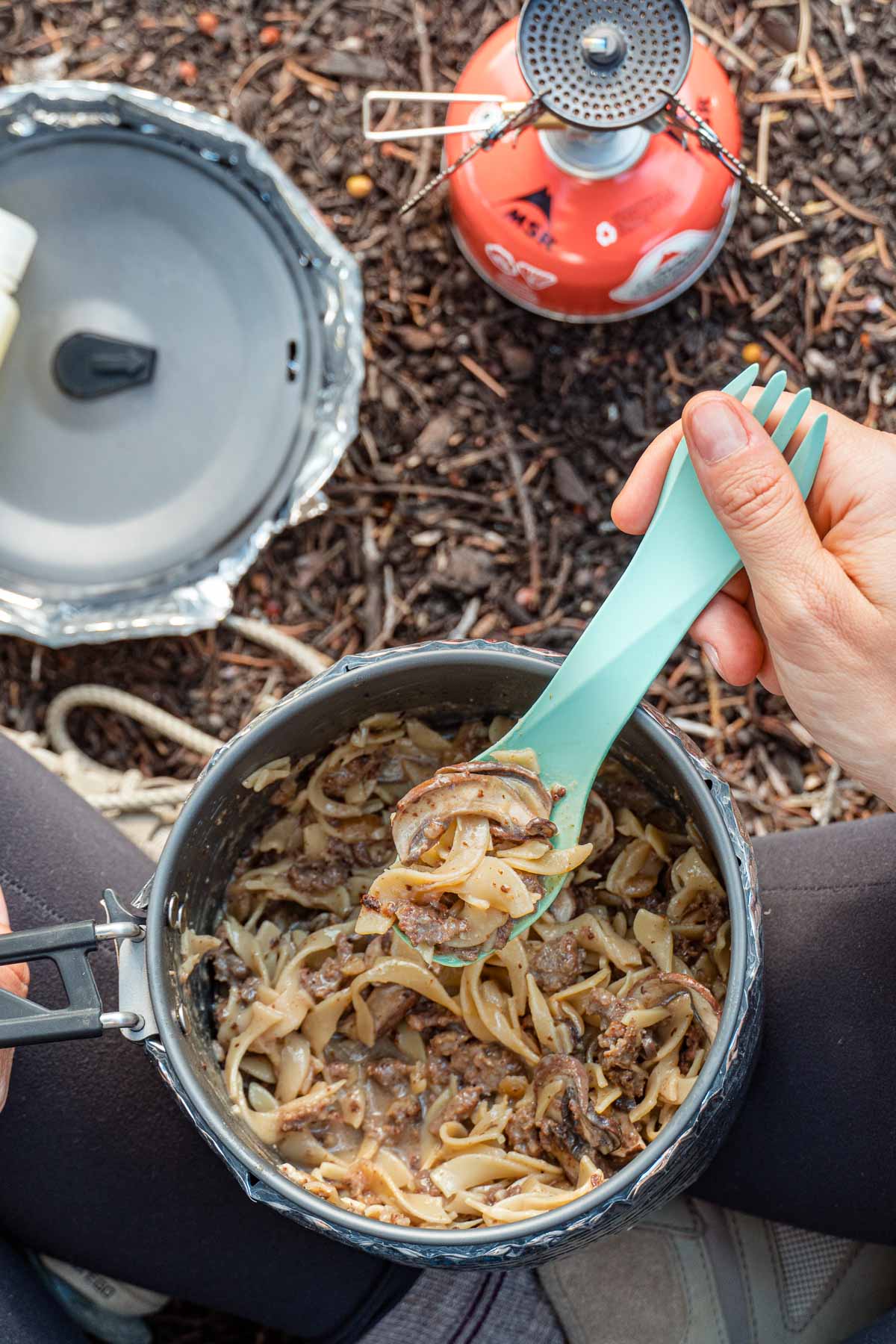
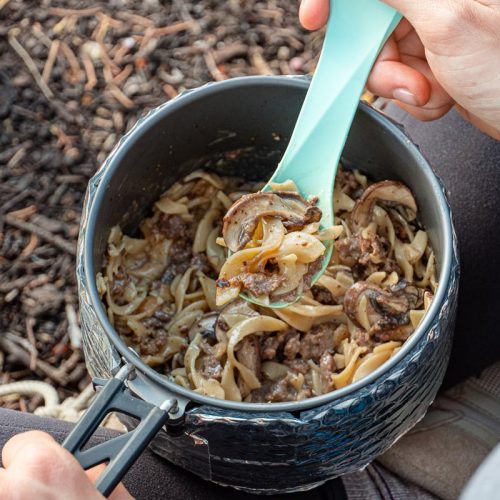
Ingredients
- 1 lb extra lean ground beef, (454 g)
- ½ cup bread crumbs, (65 g)
- 1 onion, diced (200 g)
- 4 cloves garlic, minced (20 g)
- 1 teaspoon sea salt, divided
- 1 tablespoon beef bouillon
- 1 tablespoon cornstarch
- ¼ teaspoon garlic powder
- ¼ teaspoon onion powder
- 4 oz mushrooms
- 5 oz noodles
Pack for the trail
- ¼ cup heavy cream powder, (1 tbsp per serving)
- 4 tablespoons olive oil, (1 tbsp per serving)
Instructions
- At home, start with clean, sanitized equipment, hands, and work area. This is super important for food safety when dehydrating, so wash up with soap and hot water! Preheat your dehydrator at 145F as you prep the stroganoff.
- In a bowl, mix the ground beef with the breadcrumbs until thoroughly combined. At this point, wash your hands again.
- Heat a non-stick frying pan over medium heat and add the ground beef, minced onions, and minced garlic. Use your spatula to break the meat apart as you stir it around the pan.
- Cook 15-20 minutes, until the ground beef has cooked all the way through and no pink spots remain and the onions are soft and translucent. Break apart any large clumps of meat.
- Mix the cornstarch and bouillon with about a half cup of water to create a slurry, and pour into the pan, stirring to incorporate it into the sauce. Cook about one minute more, then remove from the heat.
- While the beef is cooking, bring a pot of water to a boil and cook the noodles for a minute or two less than the package instructs you to.1
- Line your dehydrator trays with fruit leather liners, parchment paper paper, or silicone sheets. Spread the beef, sliced mushrooms, and cooked noodles onto the trays, making sure not to over-pack the trays.2
- Dehydrate at 145F for 6-12 hours.3
- Remove the stroganoff from the dehydrator and allow it to cool completely before storing it.
To pack for the trail
- Repackage the meal into single-portion zip top bags. You can add the powdered heavy cream at this time (1 tablespoon per serving). We also recommend packing about 1 tablespoon of oil per serving in a sealed container. Alternatively, you can pack single-serve olive oil packets.
On trail
- Place the meal in your cook pot along with about 200mL water per serving. Cover the pot and bring to a boil, and boil for a minute. Stir, then remove from the heat and place your pot in a pot cozy for 10 minutes or until the meal has rehydrated.4

